
Volunteer John Zuke 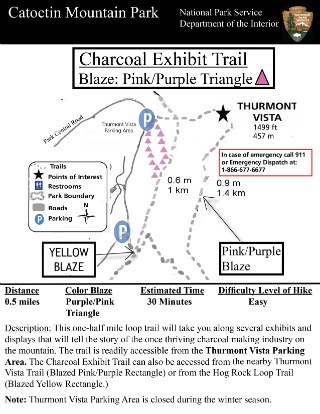
Charcoal TrailDistance: 0.5 Miles (Round Trip)Color Blaze: Pink/Purple Triangle Estimated Time: 30 Minutes Difficulty Level of Hike: Easy Description: This one-half mile loop trail will take you along several exhibits and displays that will tell the story of the once thriving charcoal making industry on the mountain. The trail is readily accessible from the Thurmont Vista Parking Area. The Charcoal Exhibit Trail can also be accessed from the nearby Thurmont Vista Trail (Blazed Pink/Purple Rectangle) or from the Hog Rock Loop Trail (Blazed Yellow Rectangle.) Note: Thurmont Vista Parking Area is closed during the winter season.
Located approximately one mile north of the Visitor Center, the Charcoal Exhibit tells the story of how the mountain supported one of the early industries of central Maryland. This half mile hike is easily accessed from the Thurmont Vista Parking Area as well as from nearby hiking trails. Step back in history and learn of the history of the Charcoal Industry on Catoctin Mountain.
The trees that posed a major obstacle to the settler were of extreme value to the burgeoning industrial revolution. The production of charcoal was a major enterprise employing over 300 woodcutters and consuming timber from 11,000 acres of company land during peak years (1859-1885). Charcoal fueled the Catoctin Iron Furnace which separated out the iron from the raw iron ore. Approximately 80 bushels of charcoal were burned for every ton of iron manufactured. It took a cord of wood to manufacture six (6) bushels of charcoal. Charcoal was one of the many fuel sources that emerged from the Catoctin Forest which is now Catoctin Mountain Park. 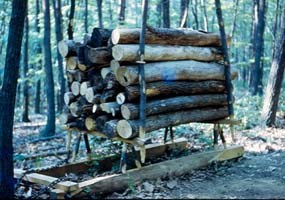
NPS Photo The woodcutters entered a forested area and cut every live standing tree. One or two trees were left to re-seed the forest. The resulting logs were carried downhill by horse or mule drawn sleds to the hearth where the wood was charred.
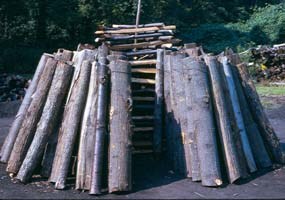
NPS Photo 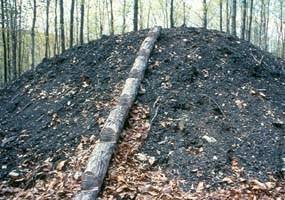
NPS Photo The collier supervised the orderly stacking of the wood. First a chimney was built in the center of the hearth; then 30 to 50 cords of four foot logs were stacked around this chimney in concentric circles. The finished stack was covered with leaves and dirt. This controlled the amount of air that reached the fire. Hot embers were dropped into the chimney on a cool, humid night. Tending the fire was a round-the-clock job so the collier lived nearby in a simple hut. He watched up to seven hearths that smoldered for two weeks until charring was complete. 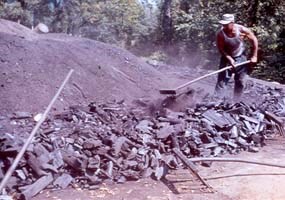
NPS Photo The charcoal was raked into small piles so that it could cool. This way any fires that would flare up would destroy only a portion of the finished product instead of the entire stack. The collier was responsible for the charcoal unit until it was delivered to the furnace. Since he was paid by the bushel, any charcoal that accidentally burned was his personal loss.
|
Last updated: June 26, 2025

